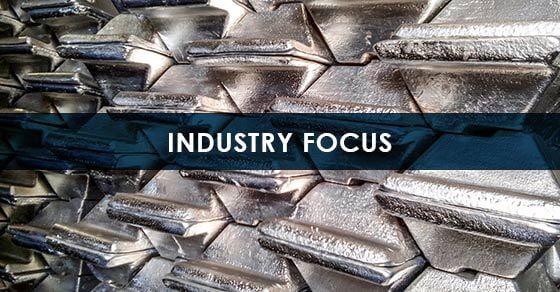Not long ago we highlighted the numerous factors causing a surge of growth in aluminum production and recycling. New applications continue to push this trend, but a few challenges could stand in the way of the industry’s growth.
As a leading supplier of aluminum decoating kilns, swarf dryers, and bulk handling equipment, as well as service support and process development capabilities, FEECO remains an important resource to the industry and continues to bring you the latest updates. Here’s what’s new with aluminum.
New Developments Driving Aluminum Production & Recycling
Eternally recyclable and incurring major energy and emissions savings as a secondary material, aluminum continues to gain an ever-stronger foothold on the efforts to build a more sustainable economy. In addition to its pivotal role in renewable energy technologies, the metal is seeing new and growing applications in:
Aluminum-Ion Batteries
Aluminum has already displaced copper and steel in many auto applications, particularly when it comes to electric vehicles, and now the metal has its sights set on lithium.
Researchers in Australia are working on a graphene aluminum-ion battery that would offer a more sustainable alternative to lithium-ion batteries.
The new chemistry boasts a longer life, a lower fire risk, and the ability to charge a whopping 70 times faster, according to the University of Queensland, where the research is being conducted. The University is working with Graphene Manufacturing Group to develop commercial prototypes for a range of consumer products.
The batteries would also inherently be more recyclable than their lithium-ion counterparts – a hurdle the current lithium-ion technology is grappling with.
As a Substitute for Copper
Exploration into using aluminum as a substitute for copper is also ongoing as the cost of the red metal continues to rise. Aluminum has already ousted copper in some settings, and with ongoing research, has the potential to continue that trend.
Infrastructure
Aluminum would also benefit from the anticipated investment in infrastructure, as it gains favor in construction applications. Skyscrapers, bridges, and more, are taking advantage of aluminum’s ductility, light weight, and resistance to rust, among other benefits.
In May, the Aluminum Association wrote a letter to Congress laying out a number of recommendations to support job creation, sustainability, and modernization through the use of aluminum in everything from energy grids to transportation infrastructure in future plans for the nation.
The recommendations also drew attention to the need to continue bolstering investment in aluminum recycling infrastructure, despite an already-high recycling rate for the metal.
Challenges Facing the Aluminum Industry
Among the ongoing uncertainty around tariffs, the aluminum industry continues to face two major hurdles as it grows:
Emissions from Primary Aluminum Production
Interestingly, aluminum’s sustainability comes with a hefty carbon footprint from the production of primary aluminum, a fact highlighted in a recent Wood Mackenzie opinion piece. Julian Kettle, the firm’s Senior Vice President and Vice Chair Metals and Mining, predicts that decarbonization efforts will not be enough to avoid a 15% increase in emissions from primary production over the next decade, due to industry expansion.
“Ironically, the rate at which aluminum industry emissions can be reduced at scale will be determined by the buildout and availability of low-carbon power, which itself requires the use of low-carbon aluminum, amongst other metals,” Kettle writes.
Kettle goes on to explain that he anticipates that while aluminum will contribute to more carbon emissions over the next decade, there will come a time when aluminum will be part of the solution.
Inklings of change have already begun, with Alcoa recently announcing plans to cut 70% of emissions in its Australia alumina refineries over the coming decade. The company has also created its own brand of low-carbon aluminum, Ecolum.
Rio Tinto has also announced plans to trial hydrogen in place of natural gas in the calcination step at its Australian alumina refineries in an effort to lower emissions.
The Aluminum Stewardship Initiative has developed a third-party Certification program to give companies an opportunity to certify their products as both responsible and sustainable according to the defined criteria.
Similarly, aluminum supplier Hydro has developed new, certified low-carbon products to help their customers meet sustainability goals.
Red Mud
Red mud, or bauxite residue, is a by-product of primary aluminum production. The waste is caustic and difficult to manage, posing environmental and social risks, as was shown when a red mud tailings dam collapsed in 2010 in Hungary, causing a deluge of devastation.
Produced at alarming rates, the waste has long been a subject of contention for the industry. However, research has shown there are a range of opportunities in beneficial reuse applications, as well as in recovering valuable components from the material.
Metal recovery is one promising avenue, as red mud is host to a number of increasingly valuable metals, including iron, aluminum, titanium, and rare earths, among other materials.
Reuse of red mud in construction materials has also been extensively explored, with potential for use in embankments, cement, road base, and more. At the end of 2020, the International Aluminum Institute launched a Bauxite Residue Roadmap in an effort to promote the use of the by-product in cement and concrete applications.
With extensive capabilities in testing and developing custom rotary kilns for recovering materials from wastes, the FEECO Innovation Center has been on the front lines of this effort, helping customers to develop processes and equipment around their red mud objectives.

Red mud samples produced through rotary kiln testing in the FEECO Innovation Center
Conclusion
Although challenges exist, the critical nature of aluminum in a low-carbon economy, paired with the wheels of change in motion, is likely to see the material continue its expansion.
FEECO engineers custom rotary dryers and kilns, as well as bulk material handling equipment for processing aluminum and its many derivatives. Our testing and development services, along with a comprehensive parts and service program for maintaining our equipment and that of our competitors, has made us a preferred provider to the aluminum industry. For more information on our aluminum capabilities, contact us today!


